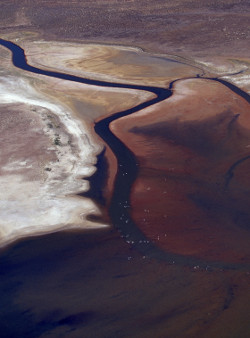|
|
Legislation, policy and other management initiatives for shorebirds and other waterbirdsThere are a range of conventions, partnerships, agreements, legislation and strategies that relate to the protection and management of waterbirds and their habitats. The diversity of cooperative management initiatives reflects, in part, the complexity of managing species that are international migrants and/or occur over large areas within Australia. It also indicates the very high level of public interest in shorebirds and other waterbirds, worldwide, which in some cases has driven the formation of mechanisms (such as the Ramsar Convention) and organisations dedicated to protection and management of wetlands and biodiversity generally. Ramsar ConventionContracting parties to the Ramsar Convention designate at least one wetland to the List of Wetlands of International Importance and promote the 'wise-use' of wetlands within their country. A number of criteria may apply – including those relating to total number of waterbirds and the proportion of a waterbird population using a site. Find out more. Bonn ConventionThe Convention on the Conservation of Migratory Species of Wild Animals, more commonly abbreviated to the Convention on Migratory Species (CMS) or the Bonn Convention, is an intergovernmental treaty established under the United Nations Environment Programme that seeks to conserve migratory species. East Asian—Australasian Flyway PartnershipInternational cooperation on shorebirds and other migratory waterbirds in the East Asian—Australasian Flyway led to the formation of the East Asian—Australasian Flyway Partnership (EAAFP) in 2006. Partners of this informal mechanism include governments, inter-governmental agencies, international non-government organisations and the international business sector. Functions include the promotion and management of key sites, the exchange of information and the cooperative management of populations of migratory waterbirds. The EAAFP maintains a Flyway Site Network, which informally recognises internationally important sites for the conservation of migratory waterbirds throughout the Flyway. Sites are nominated by Partner Governments and existing land-use is managed by the site owners. Bilateral agreementsThere are three major bilateral agreements between Australia and other countries in the Flyway that cover migratory bird species. These agreements are with Japan (JAMBA), China (CAMBA) and the Republic of Korea (ROKAMBA) and are aimed at the protection and conservation of migratory birds and their habitats, protection in relation to take or trade, building cooperative relationships and information exchange. LegislationEnvironment Protection and Biodiversity Conservation Act 1999The Environment Protection and Biodiversity Conservation Act 1999 (EPBC) (EPBC migratory species list) is federal legislation that designates Wetlands of International Importance (Ramsar wetlands), Threatened Species and Migratory Species, among others, as Matters of National Environmental Significance. A series of policy statements and guidelines, including the National Light Pollution Guidelines for Wildlife Including Marine Turtles, Seabirds and Migratory Shorebirds – 2020, provide additional information on migratory and threatened species and their habitats. Wildlife Conservation Plan for Migratory Shorebirds developed under the EPBC Act identifies research and management activities to support the conservation of these species in a nationally coordinated manner. Nature Conservation Act 1992The Nature Conservation Act 1992 (NCA) is the state legislation that provides for the protection of biota in Queensland. There are associated lists of wildlife in the Nature Conservation (Animals) Regulation 2020 of extinct, extinct in the wild, critically endangered, endangered, vulnerable, near threatened and of least concern species. The management intent for species is stated in the Regulation and includes the investigation and monitoring of populations, the formulation of management plans, habitat protection, impact assessment and mitigation, education measures, and a cooperative approach with other governments and the public. Other legislation and strategiesMarine Parks Zoning Plans also include provisions for managing shorebirds. Additionally, there are a range of programs, policy and legislation for wetlands and the habitats for which shorebirds depend upon. Local government and other initiativesThe Basin Plan for the Murray Darling provides a coordinated approach to water use across the Basin states and the Australian Capital Territory. It incorporates objectives relating to no loss of or degradation, as well as improvements in recruitment and populations of native, water-dependent species including birds. Local governments are often pivotal in efforts to manage waterbird populations. They may either have direct control over waterbird habitat or be able to influence public access or levels of disturbance to waterbirds. Local governments are responsible for the nature and extent of local development (residential, industrial, commercial) that may affect waterbird habitat. Some local governments map local waterbird habitat, erect signage, encourage monitoring, and establish policies on walking dogs and using vehicles and boats near the shoreline. View your local government website for information on shorebirds and projects in that area. A range of non-government organisations are also involved in the cooperative management of shorebirds and other waterbirds, including the: Pages under this sectionLast updated: 18 December 2020 This page should be cited as: Department of Environment, Science and Innovation, Queensland (2020) Legislation, policy and other management initiatives for shorebirds and other waterbirds, WetlandInfo website, accessed 8 May 2025. Available at: https://wetlandinfo.des.qld.gov.au/wetlands/management/bird-management/bird-legislation/ |

 — Department of the Environment, Tourism, Science and Innovation
— Department of the Environment, Tourism, Science and Innovation


